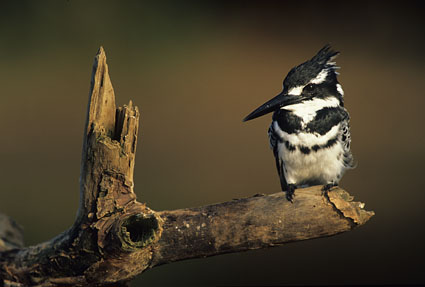Choosing the right aperture
 Due to the difficulty in approaching our subjects, telephoto lenses of between 400mm and 600mm are regarded as pretty much standard fare for bird photography. However, tele lenses have what at first may appear a great drawback in that their depth of field is extremely shallow. A 600mm F4 lens when used at its widest aperture to focus on a small bird filling the frame will have an extremely narrow plane of focus. In fact, unless the bird is exactly flat on to the camera, it will be impossible to get both the head and tail of the bird sharp.
Due to the difficulty in approaching our subjects, telephoto lenses of between 400mm and 600mm are regarded as pretty much standard fare for bird photography. However, tele lenses have what at first may appear a great drawback in that their depth of field is extremely shallow. A 600mm F4 lens when used at its widest aperture to focus on a small bird filling the frame will have an extremely narrow plane of focus. In fact, unless the bird is exactly flat on to the camera, it will be impossible to get both the head and tail of the bird sharp.
Depth of field improves as a progressively smaller aperture is used but, as less light is allowed to pass through the lens, the shutter has to remain open longer to maintain correct exposure. For each additional aperture F stop, shutter speed is halved. In other words, the 600mm lens used at its widest aperture of F4 would give a shutter speed of about 1500th second with 100ASA film in bright sunlight. Changing to F5.6 would increase depth of field slightly but would halve the shutter speed to 750th second. Correspondingly, F8 would give a speed of about 350th second; F11, 180th second and F16, 90th second. Now, at F16, there will be plenty of depth of field to get a bird in sharp focus from head to tail but the 90th second shutter speed will result in a blurred image unless the bird is sitting absolutely still. The trade-off between aperture (depth of field) and shutter speed (ability to freeze movement) is one of the fundamental compromises of photography. Unfortunately, other than using an extremely fast film which will give excessive grain, it is impossible to have the best of both worlds with both good depth of field and a fast shutter speed. The decision to opt for either depth of field or fast shutter speed will depend on the kind of results you wish to achieve with your photography. For bird portraits with the subject sitting still, a smaller aperture of say F11 would work well to give sufficient depth of field to get a sharp image head to tail. Because the subject is static, the correspondingly low shutter speed is not a problem. Remember though that tele lenses need to be kept absolutely steady with low shutter speeds so use a sturdy tripod and cable release to avoid blurred, shaky pictures. I generally focus on the eye of the bird for portraits. When the lens is stopped down, the zone of sharp focus extends one third in front and two thirds behind the point of focus. To freeze movement, it is of course necessary to use a fast shutter speed. This results in a wide aperture and shallow depth of field. Fortunately modern autofocus is so fast and accurate that a high proportion of pictures are generally in focus even with so little leeway in terms of depth of field. Often when shooting an action sequence with wide aperture/high shutter speed, it is simply impossible to achieve sufficient depth of field to get the whole bird in focus. In this instance I try to keep the autofocus sensing area in the viewfinder on the head of the bird. Even though the tail may be out of focus, the picture will generally still work. When shooting action, I use aperture priority mode on the camera set to the widest aperture to automatically maximise shutter speed. At the start of this feature I said that shallow depth of field was an apparent shortcoming with telephoto lenses. It is possible to make this limitation of the photographic medium work for you in making a bird look like it is about to jump out of the frame. By photographing in situations where the background is a considerable distance behind the subject, it registers as a mere mist of colour not unlike a watercolour wash. The result is a clean uncluttered image with the subject clearly prominent. Top | Previous | Next | Tips Home | Stock Images | Books | Tips | Gallery | FAQ's | Kruger Park | Contact Text and photograph © Nigel Dennis |